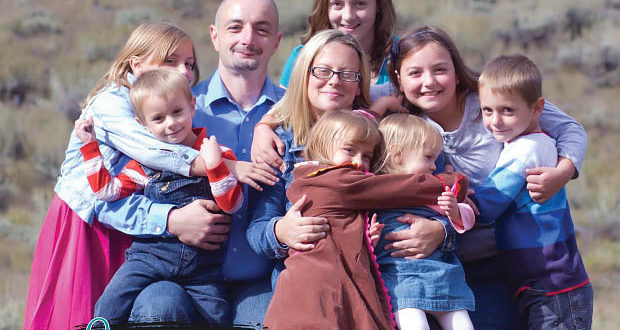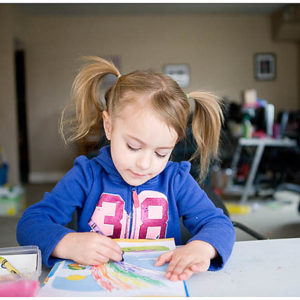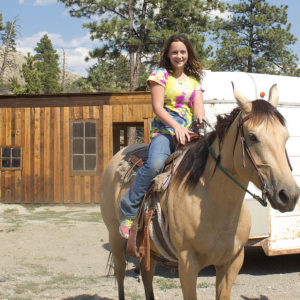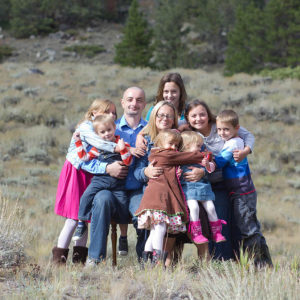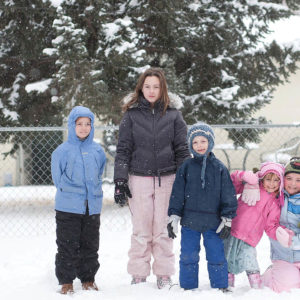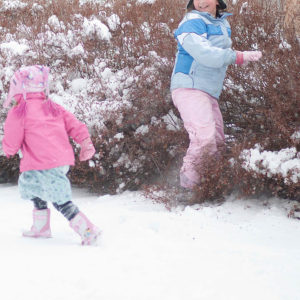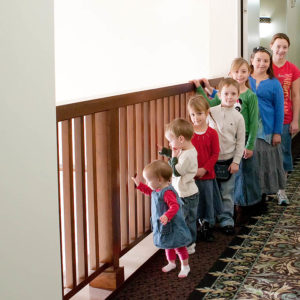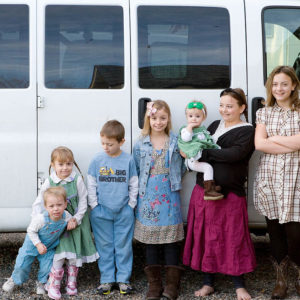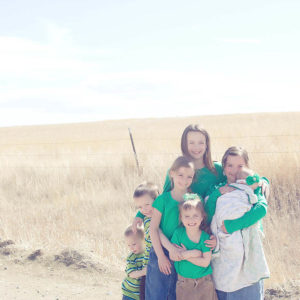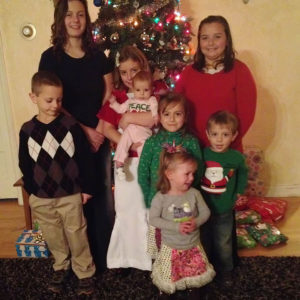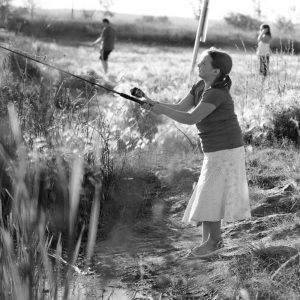by Heather Kerbis
A large homeschooling family seems natural to us now, but in the beginning, homeschooling was not on our radar. We were married relatively young, in our very early 20s, and assumed our children would go to the classroom for education. My husband Paul was educated in public elementary school and graduated from Catholic high school. I graduated from public school.
Thus, homeschooling was neither a quick nor an easy choice for us. However, just as we cannot imagine our family of eight children being any smaller, we also cannot imagine a life without homeschooling.
Give it a Try
The decision to homeschool was complex. Paul worried about whether the children would be educated well, have friends, play athletics, etc. On the other hand, I had several homeschooling friends and saw how it operated firsthand. Since he and I were on different sides of the fence, so to speak, we agreed to start out on a trial basis, taking one year at a time.
Neither Paul nor I felt boxed into a decision. If it worked out the first year, we would continue. If it did not, we would enroll them in school and proceed as so many families do.
One of Paul’s teachers from his high school years, a priest, really encouraged us both to homeschool. He observed large numbers of homeschooling families and was very impressed with their gracious children and how these homeschoolers interacted with all ages.
He told us how older children spoke with adults easily and yet knew how to include little ones in their outdoor games after church dinners. There were no fights or nervous parents worried about their children’s safety. He also spoke of how well-educated the older ones proved to be. His stories and encouragement helped provide the confidence we needed to make the attempt.
Although we are the “typical” large homeschooling Catholic family, we are not the typical homeschooling family. For one thing, Paul is a hard-rock miner in the Rocky Mountains of Montana. He is the first in his family to be a miner since his Irish great-great-grandfather was a miner handling dynamite in the 1800s.
For the last several generations, Paul’s family farmed in Iowa and Missouri–the heartland of America. Fortunes changed for his farming family at the turn of this century, as it did for thousands of farmers all over, so he searched for a job which would be more secure and offer a comfortable income.
His work entails mining palladium, the mineral used in catalytic converters to improve air quality from automobile exhaust. As a miner, his work schedule is not typical of most working fathers either. He moves back and forth between day and night shifts with four days on and four days off.
An enormous homeschooling benefit for us is that our children spend more quality time with their dad than they would if they attended a school. Paul also has a teaching gift as the math and science teacher. He has a marvelous way of explaining difficult concepts, which is not as strong in my teaching gift.
How We Work
Our goal is balance in all things. To fulfill this balance, we use the Seton curriculum for our academic study. This curriculum offers us significant study in a consecutive manner. One year’s study easily flows into the following year’s grade. The lessons are at a very strong scholastic level, which is what my husband and I strongly desire.
Seton makes it much easier for us to keep on track and increases my confidence that, when they graduate, our children will be fully educated. A good educational foundation on which they can build is such a blessing.
As Catholics, we attend Mass and practice daily prayers as a family: before meals, evening Rosary, prayers of petition, prayers to saints. We also have special devotions to St. Therese the Little Flower, and the Infant of Prague, especially through His Nine Hour Novena. Seton’s use of Catholic teaching effortlessly woven throughout the textbooks supports us in our faith.
The tension brought on by too many diverse influences in children’s lives is eliminated through homeschooling and Seton’s Catholic emphasis from beginning to end. Stunning, classic, Catholic art from ages past is also offered to help them learn the basic Catholic tenets. Even young non-readers learn through pictures, and topics throughout grade school and high school are reinforced with pictures.
We have learned that organization and consistency is the key to a happy homeschool day. School starts around 9:00 AM, following prayers, breakfast, and completed chores. The independent learners begin where they left off with occasional instruction, while the younger ones sit at the table with an individual instructional approach.
It is heartwarming to watch the ones not yet ready for preschool climb up on a chair at the table and include themselves with things like coloring, even though they hardly know how to hold a crayon. By the time they are in kindergarten, they already have a wide knowledge base. I am amazed by the way our own children reveal humanity’s ingrained desire to learn. Really, all we have to do is open the doors for them.
Studies are finished according to the individual child’s learning strengths and weaknesses, but most are finished by early afternoon. Each day seems to have a different focus: music lessons one day, soccer practice another. Through the local homeschool co-op, the children have PE once a week—canoeing, flag football, parachute games, and the list goes on.
We are a rather active family with backyard swimming in the summer, jogging and bicycling all year, and hiking in the mountains most of the year. Several children participate in 2k and 3k runs held during local celebrations. We have also become organic gardeners with much of the backyard now a garden. Different children plant little personal garden plots, and learn so much about botany.
There is gardening/science excitement every day in the summer; they also love garden snacking. Of course, we can and do freeze the bounty, learning about germs, cleanliness, and consequences of not paying attention to detail. The children take lessons in piano, flute, violin, fiddle, and cello.
Two of the children are involved in a children’s orchestra that puts on two concerts a year; four are involved in a summer fiddle club with a street concert on July 4th and at the local farmer’s market; all participate in the usual recitals that go along with all those instruments. Our family enjoys a variety of activities in an effort to become well-rounded citizens of our Church and our community.
A Good Bubble
Homeschooling allows us to observe our children’s many talents—perhaps my greatest joy is seeing how some of my children are natural-born teachers. While I am teaching one student, others automatically help those who need something explained to them.
It inspires me to see how love for one another drives them to help. Their teaching activity fulfills that old adage: “to learn something well, teach it.” Hearing their conversations, I know they truly understand and retain concepts and subjects that were previously taught. As parents, this is a wonderful reward and encouragement for our time and effort!
We truly like the “bubble” which homeschooling creates for our children. As almost everyone knows, much of our society seems to rudely intrude into the family—tugging a child one way, pushing another child a different way, spinning the family in circles—all of which increases tension within the family.
The homeschool ‘bubble’ insulates children from much of that tension so that, as they grow they have the opportunity to know and be true to themselves. Putting children on an educational “conveyor belt” for 12 years of their lives is not the ideal, and it truly hinders them from growing into the whole persons God intended them to be.
Of course, the end result of the experiment we began so many years ago is that we discovered homeschooling works out wonderfully! Both Paul and I have been enthusiastically on the same side of the fence for several years now, and together, we’ve never looked back. In this time of homeschooling, we have become an extremely close family, and know for a fact that the homeschooling itself has been instrumental in generating this close bond.
Creating confidence and trust between siblings through quality time together is a by-product of homeschooling, and it means everything in the world to me!

 Seton Magazine Catholic Homeschool Articles, Advice & Resources
Seton Magazine Catholic Homeschool Articles, Advice & Resources
